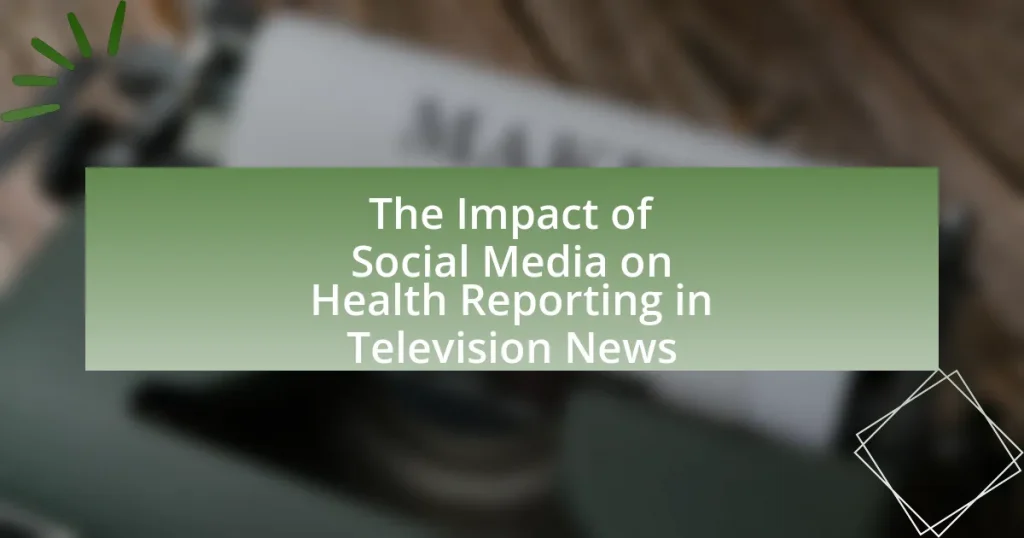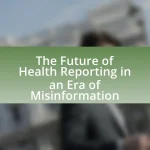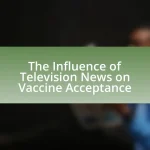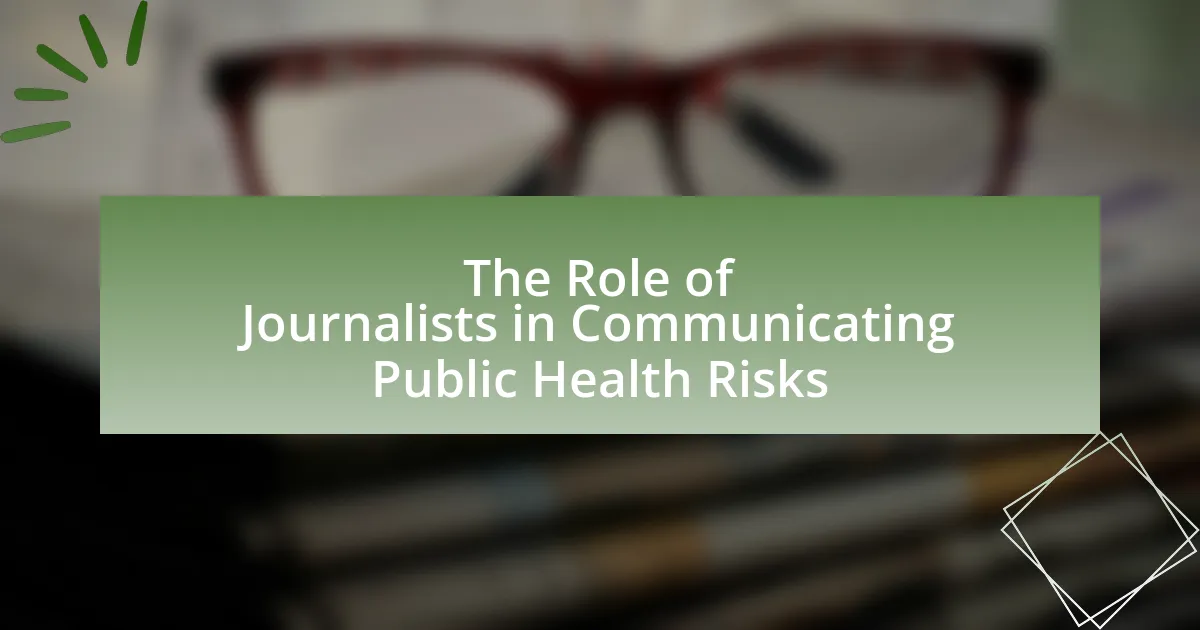The article examines the impact of social media on health reporting in television news, highlighting how platforms like Twitter and Facebook have transformed the speed and nature of information dissemination. It discusses the dual effects of social media, including increased public awareness of health issues and the risk of spreading misinformation, which can undermine trust in health authorities. Key differences between traditional and social media reporting are outlined, emphasizing the importance of accuracy and verification in health news. The article also explores the challenges faced by television news in integrating social media, the ethical considerations involved, and strategies for effective health reporting, ultimately underscoring the necessity for critical evaluation of health information by viewers.

What is the Impact of Social Media on Health Reporting in Television News?
Social media significantly influences health reporting in television news by accelerating the dissemination of information and shaping public perception. Television news outlets increasingly rely on social media platforms to gather real-time updates, which enhances the speed at which health-related news is reported. For instance, during the COVID-19 pandemic, platforms like Twitter and Facebook became primary sources for breaking news, allowing television networks to provide timely coverage based on social media trends and user-generated content. This reliance on social media can lead to both positive outcomes, such as increased awareness of health issues, and negative consequences, including the spread of misinformation. Studies indicate that misinformation on social media can lead to public confusion and mistrust in health authorities, impacting public health responses.
How has social media changed the landscape of health reporting?
Social media has transformed health reporting by enabling real-time dissemination of information and fostering direct engagement between health professionals and the public. This shift allows for immediate updates on health crises, such as the COVID-19 pandemic, where platforms like Twitter and Facebook became primary sources for breaking news and public health guidelines. According to a study published in the Journal of Medical Internet Research, 80% of internet users reported seeking health information on social media, highlighting its role as a significant information source. Furthermore, social media facilitates the sharing of personal health experiences, which can influence public perception and behavior regarding health issues.
What are the key differences between traditional and social media health reporting?
Traditional media health reporting relies on established journalistic standards, fact-checking, and expert sources, while social media health reporting often prioritizes speed, user-generated content, and viral trends. Traditional media typically involves vetted articles published by reputable organizations, ensuring accuracy and credibility, as seen in outlets like The New York Times or BBC Health. In contrast, social media platforms like Twitter and Facebook allow anyone to share health information, which can lead to misinformation and unverified claims spreading rapidly. A study by the Pew Research Center in 2021 indicated that 53% of social media users encountered health misinformation, highlighting the risks associated with the informal nature of social media reporting compared to the rigorous standards of traditional media.
How do social media platforms influence the dissemination of health information?
Social media platforms significantly influence the dissemination of health information by enabling rapid sharing and broad reach of content. These platforms allow users to share health-related articles, personal experiences, and expert opinions, which can lead to increased awareness and engagement with health topics. For instance, a study published in the Journal of Medical Internet Research found that health information shared on social media can reach millions of users within hours, amplifying its impact compared to traditional media. Additionally, social media facilitates peer-to-peer communication, where individuals can discuss health issues, thereby creating a community-driven approach to health information dissemination. This dynamic can enhance the visibility of public health campaigns and foster a more informed public.
Why is understanding this impact important for viewers?
Understanding the impact of social media on health reporting in television news is crucial for viewers because it shapes their perceptions and decisions regarding health information. Viewers rely on television news for accurate health updates, and social media can influence the framing and dissemination of these reports, potentially leading to misinformation. For instance, a study by the Pew Research Center found that 64% of Americans believe that social media has a significant impact on their understanding of health issues. This underscores the necessity for viewers to critically evaluate the sources and accuracy of health information presented in news segments influenced by social media trends.
What are the potential risks of misinformation in health reporting?
Misinformation in health reporting poses significant risks, including public health threats, erosion of trust in health authorities, and the promotion of harmful behaviors. For instance, inaccurate information about vaccines can lead to decreased vaccination rates, resulting in outbreaks of preventable diseases. A study published in the journal “Health Affairs” found that misinformation about COVID-19 vaccines contributed to vaccine hesitancy, which can undermine herd immunity and prolong the pandemic. Additionally, when health reporting is based on false information, it can create confusion and anxiety among the public, leading to poor health decisions. This highlights the critical need for accurate and reliable health information in media reporting.
How can viewers critically evaluate health news from social media?
Viewers can critically evaluate health news from social media by verifying the credibility of the source, checking for supporting evidence, and assessing the quality of the information presented. Credible sources typically include established health organizations, peer-reviewed journals, or recognized experts in the field. For instance, a study published in the Journal of Medical Internet Research found that information from reputable health organizations is more likely to be accurate compared to user-generated content. Additionally, viewers should look for citations or references to scientific studies that back up claims made in the news. Evaluating the quality of the information involves considering whether the news presents balanced viewpoints and avoids sensationalism, which can distort facts.
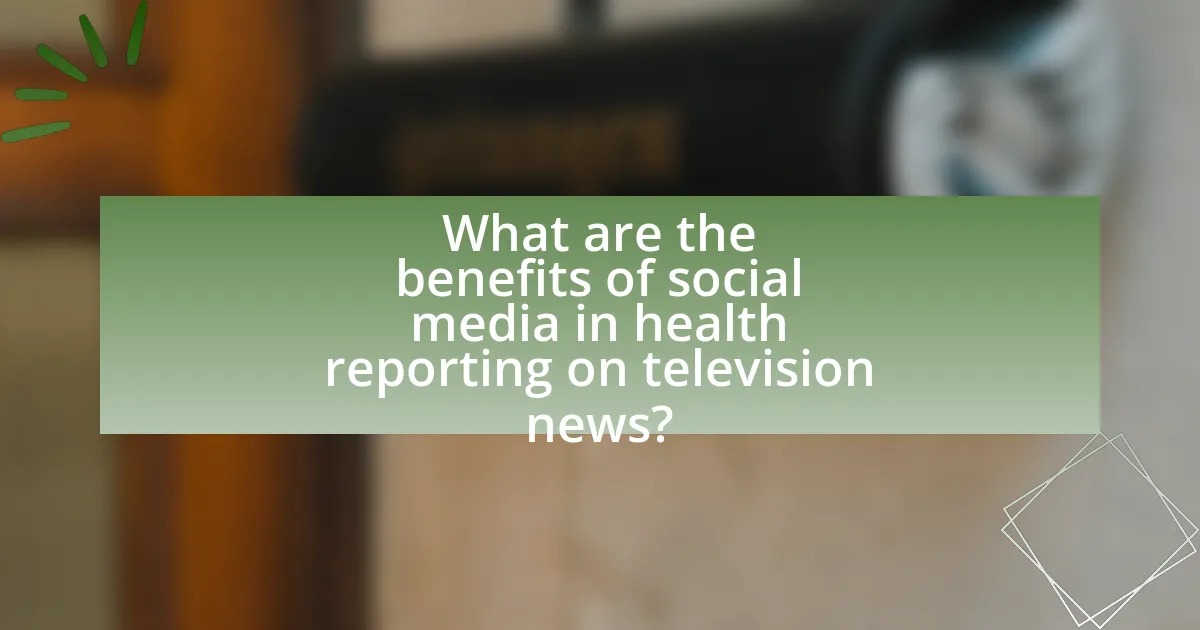
What are the benefits of social media in health reporting on television news?
Social media enhances health reporting on television news by facilitating real-time information sharing and audience engagement. This immediacy allows news outlets to disseminate urgent health updates, such as disease outbreaks or public health advisories, quickly to a broad audience. For instance, during the COVID-19 pandemic, platforms like Twitter and Facebook were instrumental in spreading vital information about safety measures and vaccination updates, reaching millions almost instantaneously. Additionally, social media enables health professionals and organizations to interact directly with the public, fostering a two-way communication channel that can clarify misinformation and provide expert insights. This engagement not only increases the credibility of the information shared but also encourages community involvement in health initiatives, as seen in campaigns that promote vaccination or healthy lifestyle choices.
How does social media enhance audience engagement in health topics?
Social media enhances audience engagement in health topics by facilitating real-time interaction and information sharing among users. Platforms like Twitter and Facebook allow health organizations and professionals to disseminate information quickly, enabling audiences to comment, share, and ask questions, which fosters a sense of community and involvement. According to a study published in the Journal of Medical Internet Research, 60% of users reported that social media influenced their health decisions, demonstrating its significant impact on audience engagement.
What role do interactive features play in health reporting?
Interactive features enhance health reporting by facilitating audience engagement and improving information retention. These features, such as polls, quizzes, and comment sections, allow viewers to actively participate in discussions about health topics, leading to a deeper understanding of the issues presented. Research indicates that interactive elements can increase viewer interest and comprehension, as evidenced by a study published in the Journal of Health Communication, which found that audiences exposed to interactive health content demonstrated a 30% higher retention rate of information compared to traditional formats. Thus, the integration of interactive features in health reporting significantly contributes to more effective communication and public awareness of health issues.
How can social media facilitate real-time updates on health issues?
Social media facilitates real-time updates on health issues by enabling instant communication and information sharing among users, health organizations, and news outlets. Platforms like Twitter and Facebook allow for rapid dissemination of health alerts, updates on disease outbreaks, and public health announcements, reaching a wide audience quickly. For instance, during the COVID-19 pandemic, the World Health Organization utilized social media to provide timely updates and guidance, significantly impacting public awareness and response. This immediacy and accessibility of information on social media enhance public engagement and awareness regarding health issues, making it a vital tool for real-time health communication.
What are the challenges faced by television news in integrating social media?
Television news faces several challenges in integrating social media, primarily including the need for accurate information verification, the rapid pace of news cycles, and the potential for misinformation. Accurate verification is crucial as social media often disseminates unverified claims, which can lead to the spread of false information in health reporting. The rapid pace of social media requires television news to adapt quickly, often compromising thorough fact-checking processes. Additionally, the prevalence of misinformation on social media platforms poses a significant risk, as it can undermine public trust in legitimate news sources. According to a study by the Pew Research Center, 64% of Americans believe that misinformation is a major problem in the news, highlighting the critical need for television news to navigate these challenges effectively.
How do news organizations ensure accuracy while using social media sources?
News organizations ensure accuracy while using social media sources by implementing verification processes that include cross-referencing information with credible sources and utilizing fact-checking tools. For instance, many organizations employ trained journalists who assess the credibility of social media posts by checking the original context, the reliability of the source, and corroborating details with established news outlets or official statements. Additionally, platforms like Twitter and Facebook have introduced verification badges and tools that help identify credible accounts, which news organizations leverage to filter information. This multi-layered approach helps mitigate the risks of misinformation, as evidenced by studies showing that verified accounts are less likely to spread false information compared to unverified ones.
What ethical considerations arise from using social media in health reporting?
Using social media in health reporting raises several ethical considerations, primarily concerning accuracy, misinformation, and patient privacy. Health reporters must ensure that the information shared is factually correct and sourced from credible medical experts or studies, as misinformation can lead to public health risks. For instance, a study published in the Journal of Medical Internet Research found that false health information spreads rapidly on social media, potentially influencing health behaviors negatively. Additionally, ethical dilemmas arise when sharing patient stories or health data, as reporters must respect confidentiality and obtain informed consent to avoid violating privacy rights. These considerations highlight the need for responsible reporting practices in the digital age.

How can television news effectively leverage social media for health reporting?
Television news can effectively leverage social media for health reporting by utilizing platforms to disseminate real-time information, engage with audiences, and enhance storytelling. Social media allows news outlets to share breaking health news instantly, reaching a wider audience than traditional broadcasts. For instance, during the COVID-19 pandemic, platforms like Twitter and Facebook were crucial for sharing updates and guidelines, with the World Health Organization reporting a significant increase in engagement on health-related posts. Furthermore, interactive features such as polls and Q&A sessions on social media enable news organizations to engage viewers directly, fostering community dialogue and addressing public concerns. This approach not only enhances the relevance of health reporting but also builds trust and credibility with the audience.
What strategies can news organizations adopt for effective health reporting?
News organizations can adopt several strategies for effective health reporting, including collaboration with health experts, utilizing data-driven journalism, and engaging with audiences through social media platforms. Collaborating with health experts ensures accuracy and credibility in reporting, as experts can provide insights and clarify complex medical information. Data-driven journalism enhances the quality of health reporting by incorporating statistics and research findings, which can help contextualize health issues and inform the public. Engaging with audiences on social media allows news organizations to disseminate information quickly, gather feedback, and address public concerns in real-time, thereby fostering a more informed community. These strategies collectively enhance the reliability and relevance of health reporting in the context of evolving media landscapes.
How can collaboration with health experts improve reporting quality?
Collaboration with health experts can significantly improve reporting quality by ensuring accuracy and credibility in health-related news. When journalists work alongside health professionals, they gain access to reliable data, expert opinions, and the latest research findings, which enhances the factual basis of their reports. For instance, a study published in the Journal of Health Communication found that news stories co-produced with health experts were more likely to provide accurate health information and reduce misinformation. This collaboration not only elevates the standard of reporting but also fosters public trust in health communications, as audiences are more likely to rely on information that is validated by qualified professionals.
What best practices should be followed when sourcing information from social media?
When sourcing information from social media, it is essential to verify the credibility of the source. This involves checking the profile of the individual or organization sharing the information, looking for established credentials, and assessing their history of accuracy. Research indicates that misinformation spreads rapidly on social media; a study by Vosoughi, Roy, and Aral (2018) published in Science found that false news stories are 70% more likely to be retweeted than true stories. Therefore, cross-referencing information with reputable news outlets and academic sources is crucial for ensuring accuracy. Additionally, understanding the context in which the information is shared, including the potential biases of the platform or user, further enhances the reliability of the sourced information.
What tools and resources are available for improving health reporting?
Tools and resources available for improving health reporting include data analytics software, social media monitoring tools, and training programs for journalists. Data analytics software, such as Tableau or Google Analytics, enables reporters to analyze health trends and outcomes effectively. Social media monitoring tools, like Hootsuite or Brandwatch, help journalists track public sentiment and emerging health issues in real-time. Additionally, training programs offered by organizations like the Association of Health Care Journalists provide journalists with the skills necessary to report accurately on health topics, ensuring that information is both reliable and relevant. These resources collectively enhance the quality and accuracy of health reporting in television news.
How can data analytics enhance the understanding of audience needs?
Data analytics enhances the understanding of audience needs by providing insights into viewer behavior, preferences, and engagement patterns. By analyzing data from social media interactions, television ratings, and audience feedback, broadcasters can identify which health topics resonate most with viewers. For instance, a study by the Pew Research Center found that 62% of adults get health information from social media, indicating a significant audience interest in health-related content. This data allows news organizations to tailor their reporting to address specific audience concerns, ultimately improving viewer satisfaction and engagement.
What training is necessary for journalists to navigate social media effectively?
Journalists require training in digital literacy, social media ethics, and audience engagement strategies to navigate social media effectively. Digital literacy training equips journalists with the skills to critically evaluate information sources and understand platform algorithms, which is essential for accurate reporting. Social media ethics training emphasizes the importance of verifying information before sharing and understanding the implications of misinformation, particularly in health reporting. Audience engagement strategies help journalists connect with their audience, fostering trust and encouraging dialogue. Research by the Pew Research Center indicates that 53% of social media users expect news organizations to correct misinformation, highlighting the need for journalists to be adept in these areas.
What are the future trends in health reporting influenced by social media?
Future trends in health reporting influenced by social media include increased real-time reporting, personalized health content, and greater audience engagement. Social media platforms enable journalists to disseminate health information rapidly, allowing for timely updates during health crises, as seen during the COVID-19 pandemic when platforms like Twitter and Facebook became primary sources for breaking news. Additionally, the use of data analytics on social media allows for the tailoring of health messages to specific demographics, enhancing relevance and impact. Engagement metrics from social media also encourage health reporters to create interactive content, fostering a two-way communication channel with audiences, which can lead to improved public health outcomes.
How might emerging technologies shape the future of health news reporting?
Emerging technologies will significantly shape the future of health news reporting by enhancing real-time information dissemination and improving audience engagement. For instance, advancements in artificial intelligence and machine learning can analyze vast amounts of health data quickly, allowing news outlets to provide timely updates on health crises, such as pandemics. Additionally, the integration of augmented reality and virtual reality can create immersive experiences for viewers, making complex health information more accessible and understandable. According to a 2021 study by the Pew Research Center, 53% of Americans reported that they often get health news from social media, indicating a shift towards digital platforms for health information. This trend underscores the importance of leveraging emerging technologies to meet audience demands for immediate and interactive health news reporting.
What role will user-generated content play in future health reporting?
User-generated content will play a significant role in future health reporting by providing real-time insights and diverse perspectives on health issues. This content allows for a more inclusive representation of public health experiences, as individuals share their personal stories and challenges related to health. Research indicates that 72% of internet users engage with health-related content on social media, highlighting the potential for user-generated narratives to influence public understanding and awareness of health topics. Furthermore, user-generated content can enhance the credibility of health reporting by incorporating firsthand accounts, which can resonate more with audiences compared to traditional reporting methods.
What practical tips can enhance the quality of health reporting in television news?
To enhance the quality of health reporting in television news, journalists should prioritize accuracy, clarity, and context. Accurate reporting involves verifying information through credible sources, such as peer-reviewed studies or expert interviews, to ensure that the health information presented is reliable. Clarity can be achieved by using simple language and avoiding medical jargon, making the content accessible to a broader audience. Providing context is essential; reporters should explain the significance of health findings, including statistics that illustrate the impact on public health, such as the CDC’s data showing that 1 in 4 adults experience mental health issues. By implementing these practical tips, television news can improve the effectiveness and trustworthiness of health reporting.
